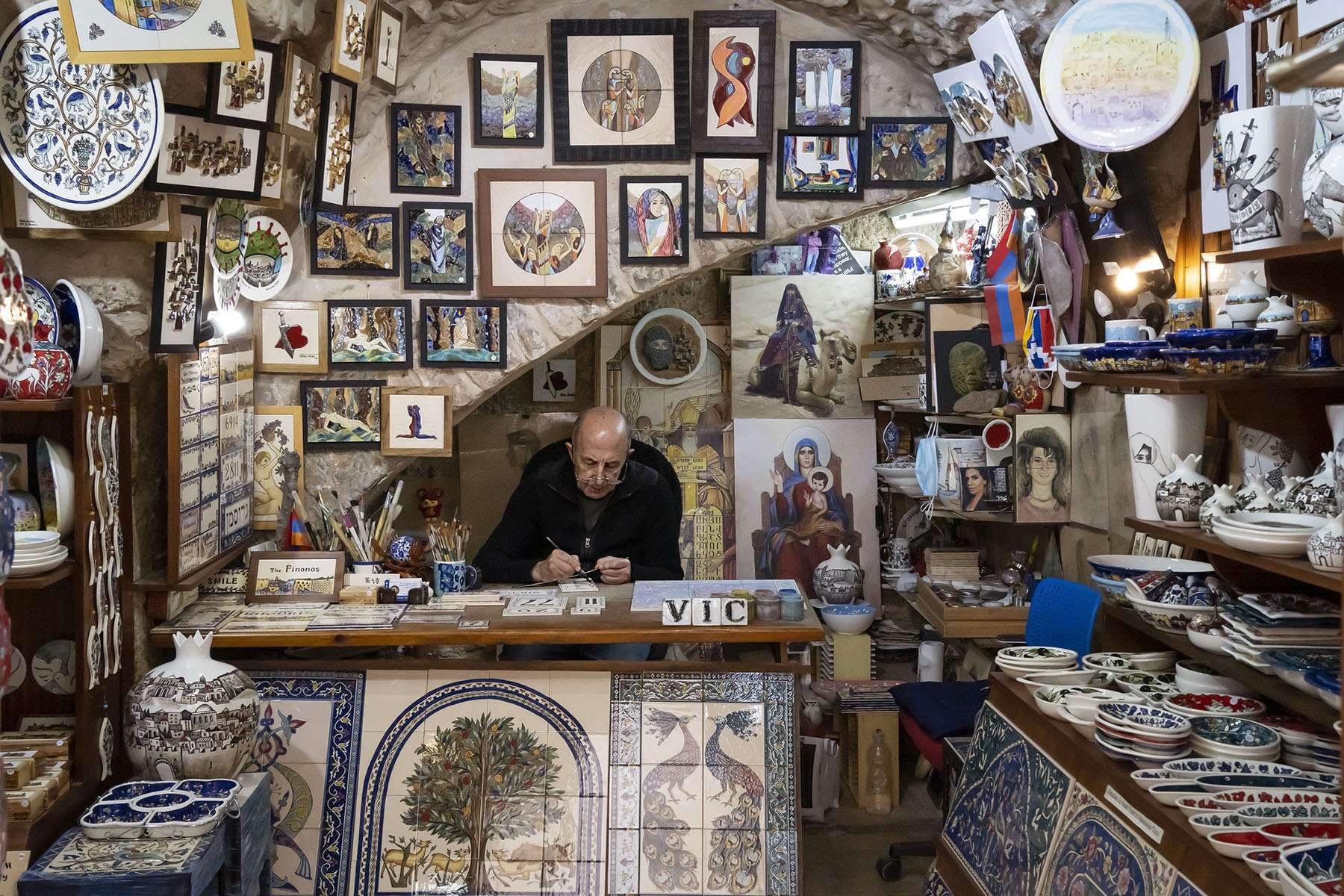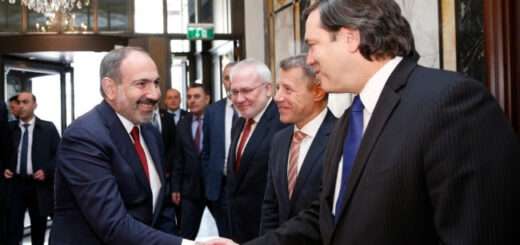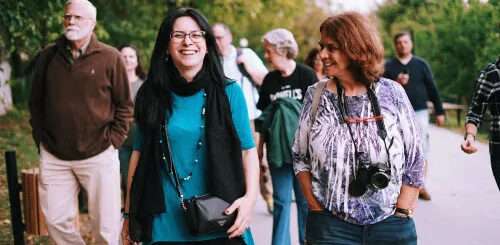Stenographic Journalism: How the Media Fails Armenia and Palestine

By Gabriel Polley, Themarkaz.org
Backed by powerful state players, western media condones genocide by effectively ignoring two peoples’ experiences of violence and displacement. A new book examines the history of colonization and the ongoing parallels between the conflicts in Artsakh and the Gaza Strip. To prevent further loss of life and the erasure of culture heritage, awareness and action are needed to challenge myopic, ill-informed, and dangerous news narratives.
Media Framing and the Destruction of Cultural Heritage: News Narratives about Artsakh and Gaza by Mischa Geracoulis
Media tells us not only about political events such as occupations, wars and genocides, and what happens to cultural heritage during them — it tells us what to think about them. This is central to Media Framing and the Destruction of Cultural Heritage by Mischa Geracoulis, a human rights journalist and Managing Editor at Project Censored who is a contributing editor and writer at The Markaz Review.
Geracoulis’s two case studies are highly significant to her: she is of Armenian descent, and the Palestinian cause is evidently close to her heart. Her twinning of Artsakh and the Gaza Strip reveals the underlying connections between the colonial violence inflicted on the two regions, against not only people but also culture. And in both Artsakh and Gaza, this destruction of heritage has frequently been dismissed by powerful media platforms, and disregarded by those who pose as culture’s strongest defenders.
 Few nations have histories as intertwined, and parallel, as Armenians and Palestinians. Following Armenia’s fourth-century adoption of Christianity, Jerusalem became an object of veneration, destination of pilgrimage, and home to monastic communities. As recounted in Boris Adjemian’s recently republished The Brass Band of the King, Palestine was a gateway through which Armenians discovered the world — centuries of amicable contact with Ethiopian monks in Jerusalem led to a privileged position for the Armenian diaspora in the court of the Ethiopian Emperor.
Few nations have histories as intertwined, and parallel, as Armenians and Palestinians. Following Armenia’s fourth-century adoption of Christianity, Jerusalem became an object of veneration, destination of pilgrimage, and home to monastic communities. As recounted in Boris Adjemian’s recently republished The Brass Band of the King, Palestine was a gateway through which Armenians discovered the world — centuries of amicable contact with Ethiopian monks in Jerusalem led to a privileged position for the Armenian diaspora in the court of the Ethiopian Emperor.
In the early 20th century, Palestine became a place of refuge for thousands of Armenians escaping genocide inflicted by the dying Ottoman Empire, perpetrated in Geracoulis’s words to “[clear] the way for a Turkish ethnostate.” Up to 1,500,000 Armenians were killed, and their villages in southeastern Türkiye — referred to by Armenians as Western Armenia — wiped off the map. Thousands of Armenians became refugees for a second time, alongside an estimated 750,000 Arab Palestinians, during the ethnic cleansing of Palestine by Israeli forces in 1948 and after. As Geracoulis writes, Israel’s subsequent Nakba denialism “rings similar to the Turkish Republic’s fiction regarding its former Armenian population.” She recounts these pivotal events briefly but sensitively, making her book a valuable introduction to the Armenian and Palestinian causes, as well as a vital message for practitioners in media, cultural heritage and human rights.
In all past atrocities afflicting Armenians and Palestinians, their cultural heritage has been destroyed. The latest wave of brutality since 2023 has been no exception. This has been no mere byproduct of war, but a deliberate strategy within a genocide. As Geracoulis aptly states, “The removal of a targeted group’s cultural heritage removes proof of that group’s existence, ultimately distorting reality.”
Armenian Palestinians are most associated with Jerusalem’s Armenian Quarter, where between 1,000 and 2,000 live today, in defiance of Israeli settler land grabs. Yet the Armenian presence is felt around Palestine. Recently visiting Ramallah’s historic Christian cemetery, I was struck by the number of Armenian Palestinian memorials, many from the period including the genocide. One gravestone, inscribed in Arabic and Armenian, commemorated Hagop Hagopian, 1853–1936, and Vahan Hagopian, 1890–1962, both pharmacists (and perhaps father and son). Almost 90 years from Hagop’s death, the year of the outbreak of the Palestinian Arab Revolt against British and Zionist colonialism, both his homeland and adopted home continue to be mired in suffering.
Geracoulis focuses on the specific cases of Artsakh and Gaza since 2023. Artsakh, also known as Nagorno-Karabakh, has had an indigenous Armenian population for over two millennia; Soviet border divisions, however, awarded the 3,170 km2 territory to Azerbaijan. Since the late 1980s, Azerbaijan — a close ally of both Türkiye and Israel, with which it trades oil and weapons — has launched repeated attacks on Artsakh. In September 2023, after a ten-month blockade, an Azeri assault led to the expulsion of its entire Armenian population of 120,000. Days later, Israel began its massive assault on the Gaza Strip, which has lasted almost two years and claimed at least 62,000 mainly civilian Palestinians, as of early September 2025. As the activist Arshak Makichyan, cited by Geracoulis, has noted, the lack of consequences for Azerbaijan effectively empowered Israel to initiate its mass murder of Palestinians. “These atrocities and subsequent impunity inspire one another.”
In all past atrocities afflicting Armenians and Palestinians, their cultural heritage has been destroyed. The latest wave of brutality since 2023 has been no exception. This has been no mere byproduct of war, but a deliberate strategy within a genocide. As Geracoulis aptly states, “The removal of a targeted group’s cultural heritage removes proof of that group’s existence, ultimately distorting reality.” Azerbaijan’s destruction of ancient churches and thousands of khachkars (carved stone crosses) in historic Armenia, like Israel’s bombing of historic mosques and libraries in Gaza, aims at the erasure of Armenians and Palestinians from the past as well as the present.
As indicated in the title of Geracoulis’s work, her primary concern is to call out the media’s failure to report the full extent of the cultural destruction wrought in Artsakh and Gaza. She identifies “stenographic journalism” which merely repeats official government narratives, often at the behest of slick Azeri, Turkish, and Israeli lobbies, as a major determinant of this inadequate coverage. Another object of Geracoulis’s critique is the UN body with responsibility for culture, UNESCO. She lays bare the close connections between UNESCO and Azerbaijan’s ruling Aliyev dynasty, resulting in the UN’s inertia in defending Armenian heritage. And while UNESCO has documented the heritage sites damaged or destroyed in Gaza, it has revealed itself toothless when it comes to stopping this wanton barbarity.
The cultural destruction in Armenia and Palestine is so vast that Geracoulis’s slim volume barely scratches the surface. Media Framing can provide only an overview of concepts such as cultural heritage, its destruction during genocides, and the moral duty of the media to challenge it. Yet what is needed today is just such an introductory primer. The cultural erasure of Artsakh’s Armenian heritage by Azerbaijan continues apace, with the movement of Azeri populations into Armenian villages and cities such as Stepanakert. In Gaza, at the time of writing, talk of a ceasefire remains empty rumor, with no Western country or international body willing to apply adequate pressure on Israel to end its genocide. Geracoulis’s work is an urgent clarion call for action to stop these atrocities. It is left to other scholars, journalists, and legal experts to more fully document what crimes have been committed and hold the perpetrators to account.





